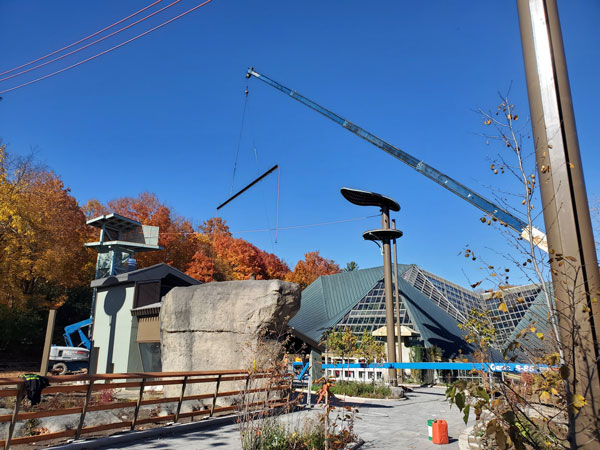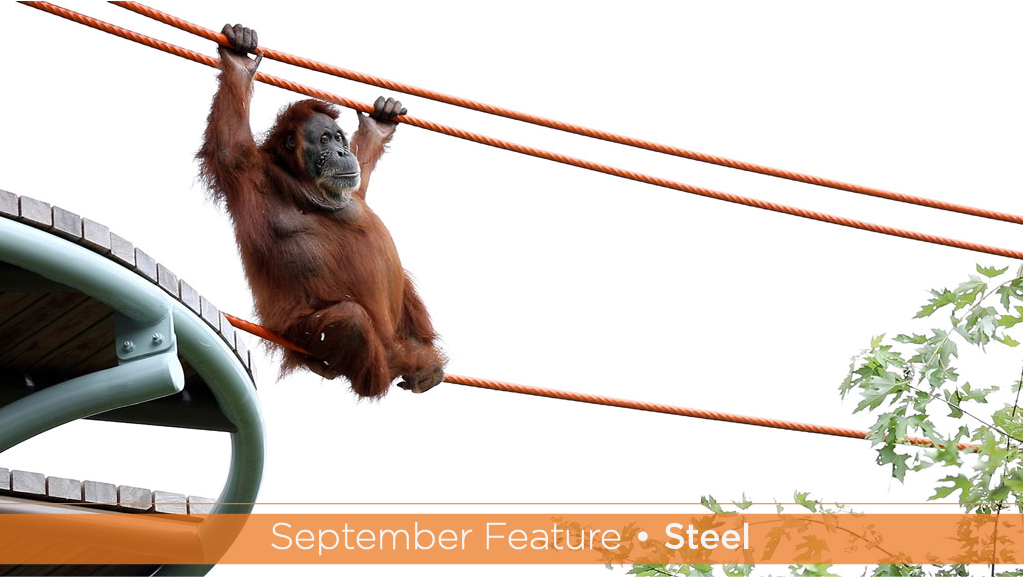At the recently opened Orangutans of Gunung Leuser, Guardians of the Rainforest Habitat at the Toronto Zoo, seven orangutans are slowly and cautiously getting used to a series of eight cantilevered HSS steel poles and three 25-millimetre-thick diameter steel cables extending from pole to pole which will allow them to climb and walk.
The designers, planners, builders, numerous subcontractors and consultants who created the habitat and, in particular, the climbing system had to be as equally careful and precise. Construction started in August 2020, with the steel erection commencing in March 2022.
“Orangutans are arboreal, or tree dwelling creatures, and the poles will function as trees,” says zoo project manager Ben Knoop, pointing out ropes and firehouses hanging from the poles mimic vines.

15 metres high and two others, with respective heights of 17.5 and
21 metres. About three-quarters of the way up on each pole is a
circular platform for the primates to sit down and eat.
Comprised of two habitats, the area is a modern facility that provides the orangutans with outdoor access that previously hadn’t been available, he says.
The habitat was designed by Zeidler Architecture Inc. in association with Jones & Jones Architects and Landscape Architects Ltd, a firm with a speciality in zoo design.
Other project partners included structural consultant RJC Engineers, general contractor Midome Construction and Allsteel Fabrication Inc., the Kitchener, Ont.-based steel detailer, fabricator and erector.
A considerable amount of research and planning had to be conducted in the pre-design and design stages before the habitat was finalized in early 2020, says Knoop.
As part of that research, the Toronto Zoo and its consultants contacted numerous other zoos for planning and design advice and referenced Association of Zoos and Aquariums animal care manuals. The association is a global non-profit network of more than 6,000 zoo and aquarium professionals, organizations and suppliers.
Every effort was made to provide for the orangutans’ safety and comfort.
The climbing system is comprised of six poles ranging from 14 to 15 metres high and two others, with respective heights of 17.5 and 21 metres.
About three-quarters of the way up on each pole is a circular platform for the primates to sit down and eat. At the very top are shade “leaves” to keep them cool on hot days. There are also drinking fountains at the top of some towers, says Knoop.

Ranging from 10- to 76-metres-long, the steel cables were treated with a special coating to protect the orangutans’ hands and the 25-millimetre-diameter setting was specifically chosen so the cables would be easy to grab, he says.
From a structural design perspective, the project was a complex undertaking requiring a full bottom-to-top analysis using “fairly sophisticated” in-house software, says RJC Engineers principal John Kooymans.
“We had to balance the softness of the foundation conditions with the right stiffness for the cantilevered poles and the loads in the cables. Getting the right cable geometry onsite was imperative, as the orangutans have a very long reach. So the cables could not sway or deflect too much under their weight, especially near adjacent trees.
“At the end of the design process, we established what length each cable had to be and what pre-load we would put into each cable by bringing them into position.”
Extensive “back and forth” consultation had to be conducted between the zoo and its consultants to finalize the steel design after Allsteel was awarded the contract in the spring of 2020, says company owner Mike Hart.
Installation field tests were conducted at its Kitchener facility to ensure there would be no complications or problems when it came to the actual onsite erection. Three cranes were used, a 40-ton, a 50-ton and 400-ton.
“It’s not that they (the components) were that heavy, rather it was the long reaches required,” says Hart, referring to a long reach over a ravine which is crossed by a tributary of the Rouge River.
Conducted concurrently with the work performed by Midome, the steel installation required a certain amount of co-ordination with other subcontractors, an example being the installation of electric wiring in the columns for a camera system.
Construction has been substantially completed and the habitat was open to the public on Canada Day. At this point only one orangutan, known as Puppe, has been adventuresome to climb the poles, says Knoop.
“The zoo staff are giving are the orangutans every opportunity to explore at their own pace.”
As for the habitat’s title, Orangutans of Gunung Leuser, Guardians of the Rainforest, it is a reference to the Leuser National Park which is home to 85 per cent of the remaining orangutans in the Sumatra Island of Indonesia, says zoo media spokesperson Amy Naylor.
Orangutans are under threat as their natural habitat is being removed for planting palm trees for oil extraction.



Recent Comments